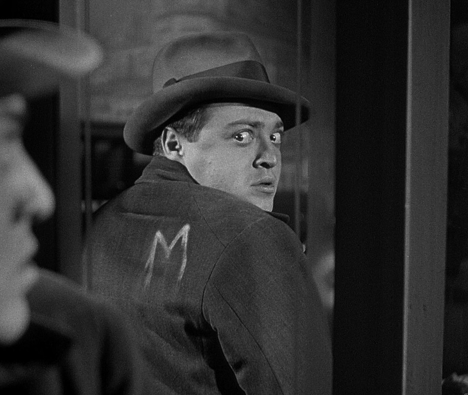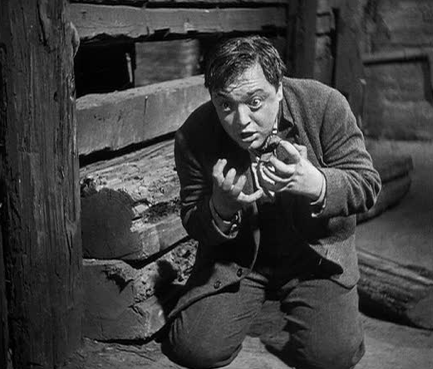Before Fritz Lang died, he had established himself as the titan of German Expressionist cinema, and he often referred to this week’s movie recommendation, M (1931), as his masterpiece.
 The film deals with the murderous impulses of Hans Beckert, played so well by Peter Lorre that he would reprise a similar character in many of his later films. Beckert is feeble and ashamed, and despite his awareness of the reprehensibility of his actions, he is unable to restrain himself. Beckert’s drive to kill children, however, is less of a focus in the film as is the community’s response engendered by his actions. In increasing desperation, the community turns from reliance on law enforcement to the organised crime underworld in an effort to apprehend Beckert by any means necessary. In so doing, they reveal their own pathetic susceptibility to bend rules for convenience’s sake.
The film deals with the murderous impulses of Hans Beckert, played so well by Peter Lorre that he would reprise a similar character in many of his later films. Beckert is feeble and ashamed, and despite his awareness of the reprehensibility of his actions, he is unable to restrain himself. Beckert’s drive to kill children, however, is less of a focus in the film as is the community’s response engendered by his actions. In increasing desperation, the community turns from reliance on law enforcement to the organised crime underworld in an effort to apprehend Beckert by any means necessary. In so doing, they reveal their own pathetic susceptibility to bend rules for convenience’s sake.
The final scene is one of the most iconic in cinema history, as Beckert is brought before a kangaroo court. The prescience of that scene in particular, in light of events that would unfurl shortly after the film’s release, is uncanny. The judge, wearing a long black leather coat redolent of the SS uniform, presides over the perfunctory trial of a Jew whose fate has long been decided. The procedural rules of the trial are improvised ad hoc to satisfy the braying of the crowd; moreover, the defence counsel is as useful as a mantelpiece ornament, and noncommittal to boot.
M takes us back to the dawn of ‘talkie’ films. In it, Lang capitalised on the novel addition of sound to the medium, varying between quiet scenes and loud cacophonies of dissonant music, narration, sound effects, and evocative whistling in quick succession of one another. Lang was a master of symbolism, and deployed all the tools at his disposal to maximal effect. His tricks have been reproduced in countless films since, almost identically.
- Like Kubrick’s The Shining (1980), the scenery in M is architecturally impossible, as is the lighting and use of shadow. Each contributes to the acute sense of claustrophobia and disorientation.
- Like Scorsese’s The Departed (2006), Lang illustrates the frailty of the distinction between good and evil by juxtaposing scenes of law enforcement with those of criminals, each of which is going about their respective business in similar fashion.
- Like Leone’s Once Upon a Time in the West (1968; reviewed here), Lang assigned the protagonist a jarring leitmotif (Grieg’s ‘In the Hall of the Mountain King’). The childlike cadences of the music disconcert audience members in light of the terrifying impulses towards children that they portend.
…The list could go on.
Not long after M’s release, both Lang and Lorre went into self-imposed exile in the States. Lang’s reasoning traces itself to a meeting with Goebbels, arranged shortly after the release of M. As a consequence of the film’s enormous success, Goebbels invited Lang to steer the newly-formed Nazi film industry. In response, he left the country. Lorre’s exile was accompanied with a little more flair: before leaving the country, he wrote a letter to Goebbels stating that ‘there isn’t enough space in Germany for two child-murderers like Hitler and Beckert.’
In 1936, while in the States, Lang made a lesser-known companion film to M, entitled Fury, which expanded on his preoccupation with ochlocracy that he first introduced in M. The parallels between the two films are too close not to dwell on at least momentarily: in both films, the protagonist is accused of kidnapping and murdering a young girl, and in both films, the citizens are whipped up into a frenzy in their pursuit of someone – anyone – to account for the crime. However, while in M the protagonist is indeed guilty, in Fury the protagonist is innocent. The distinction proves horrifyingly irrelevant, as the final message of both films is how ineffectual the justice system can be when set against a community’s retributive appetite. Perhaps as a showcase to Lang’s disenchantment with both notions of justice and of populism engendered by his personal experiences in Germany, the result in both films is eerily similar.
If we are to read anything into Lang’s filmography, he was a profoundly embittered man. Themes of revenge, oppression, aberration, credulity, and misogyny animate almost all of his films. However, bleak as they are, few directors have captured them on screen as successfully and evocatively as did Lang.
I managed to find an open source version of M at this link, but it doesn’t have subtitles. If you have better luck, please do let the rest of the RBC know in the comments section.

I’d be surprised if there’s a decent non-pay link anywhere for it, as M is in copyright in its nation of origin (Germany). There is, however, an excellent Criterion Collection disk of M (although not one of Fury, which I agree is an exceptional journey into the darkness of ex ante responses to horror) that should be available from your favorite online retailer… or local library.
It was a bit jarring to see your recommendation of M - it seemed like recommending the Mona Lisa, Hamlet, or Beethoven’s Ninth. Then again, many of the great classic films are being overlooked and forgotten these days. So kudos to you, keeper of the flame — I must congratulate you once again for a fine pick. Ich muss, ich muss!
Full marks for ochlocracy, a nice term new to me. But I question redolent; the feelies haven’t yet got round to smell, though they are working on it.
Duly noted. I’ll think a little more before using redolent next time. Nonetheless, dictionary.com has me using it correctly (see the third meaning):
http://dictionary.reference.com/browse/redolent?s=t
p.s. How does one do rich formatting in these comments (italics, hyperlinks, etc.)?
Extremely thoughtful review of a shattering film experience. I am not sure I will ever forget those progressive shots accompanied by Elsie’s mother calling her name repeatedly.
In the trial scene, the judge is a murderer, which leads to a fascinating debate between him and the defense counsel. They argue over whether a murderer who kills calmly and on purpose like the judge is better or worse than one who kills out of irresistible impulse.
RBCers who want to see another classic of German expressionism (with impossible architecture) may enjoy this prior film recommendation
https://thesamefacts.com/2012/10/popular-culture/film-popular-culture/weekend-film-recommendation-the-cabinet-of-dr-caligari/
the ‘architecturally impossible’ link: fascinating stuff!
I’m somewhat disappointed with the description offered in the post. It oversimplifies both the film proper and Lang’s general exploration and, at the same time, overstates a few aspects. Consider, for example,
In increasing desperation, the community turns from reliance on law enforcement to the organised crime underworld in an effort to apprehend Beckert by any means necessary. In so doing, they reveal their own pathetic susceptibility to bend rules for convenience’s sake.
The use of the term “community” is a bit puzzling, as Lang clearly intended the “community” in M to be criminal. In this regard, Lang echoes Brecht. Indeed, one can read much into the connection between the criminal enterprise in M and Nazis’ rise to power, but it hardly seems likely that Lang was looking into the future while making this particular film.
Second, the Peer Gynt theme is used far more for its dramatic effect and repetitive elements than for “childlike cadence”. Furthermore, the theme is suggestive of “inner demons”, which relates to other elements of the film. Note a number of hypnotic elements in tore displays and other constructs that Lang fabricates for the film. It is not accidental that the film is classified as Expressionist, as the entire style bears close relationship with psychoanalysis, which is a rather thinly veiled subtext of the film.
Third, there is more than a passing parallel between the overtly legal “police” world and the subterranean world of what amounts to a giant organized criminal gang. It’s not just that Lang portrays both of them methodically going about their business. Each encroaches on the ostensible domain of the other — the gang takes over policing and prosecution of a crime (which impinges on their own enterprise by prompting increased police scrutiny — an element that is made quite explicit in the film) while the police bend the rules and skip required steps to shortcut their own investigation. There is an additional moral message that Lang buries in the film that criminal enterprises can be more efficient than those of the state, although there is no underlying condemnation of the state as being inefficient or even a specific suggestion that traces this inefficiency to particular bureaucratic rules. In fact, Lang appears to suggest just the opposite — however more efficient the criminal enterprise may be in meeting out justice, this efficiency comes at a price and we may well be much better off to let the wheels of justice turn slowly (note that some of the inefficiency in the film is directly attributable to interference by the “Union” and yet the justice catches up before it’s too late.
I also think it is a mistake to characterize the defense representative at “trial” as useless. In fact, he nearly succeeds in shaming the “jury”. This is particularly interesting as the film was released a full two years prior to the Reichstag fire and the subsequent trial where Dimitrov availed himself of similar tactics.
It is also a mistake to ignore the underlying reasons for both Lorre and Lang fleeing Nazi Germany. It was not merely the result of disgust and culture clash, but the fact that both were in fact Jewish. Lorre was born in an assimilated, secularized Jewish family, while Lang’s mother was a Jewish convert into Catholicism (unlike other German Jewish converts, she converted not at marriage, but when Lang was already quite old — 10, I believe). The idea that Goebbels would have let a half-Jewish Lang take over the film division of the Nazi propaganda engine is preposterous. While there were quite a few German intellectual emigres (conductor Otto Klemperer being perhaps one of the most famous), the reason for Lang and Lorre was much simpler — self-preservation.
You might be surprise at the number of secularized/converted people of jewish descent who stayed in germany, or at least who didn’t think about leaving until rather later. (Although it’s anecdata, I can think of three relatives from two different family branches right off.)